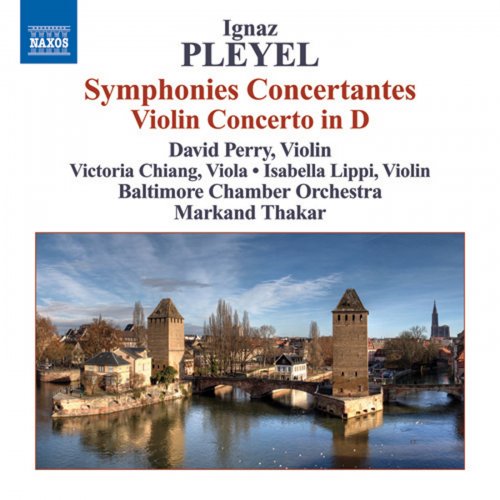
David Perry, Victoria Chiang, Isabella Lippi, Baltimore Chamber Orchestra, Markand Thakar - Pleyel: Symphonies concertantes, Violin Concerto in D Major (2009)
BAND/ARTIST: David Perry, Victoria Chiang, Isabella Lippi, Baltimore Chamber Orchestra, Markand Thakar
- Title: Pleyel: Symphonies concertantes, Violin Concerto in D Major
- Year Of Release: 2009
- Label: Naxos
- Genre: Classical
- Quality: flac lossless (tracks) +Booklet
- Total Time: 01:31:22
- Total Size: 370 mb
- WebSite: Album Preview
Tracklist
01. Symphonie concertante in B-Flat Major, B. 112: I. (Allegro)
02. Symphonie concertante in B-Flat Major, B. 112: II. Rondo moderato
03. Symphonie concertante in A Major, B. 114: I. Allegro
04. Symphonie concertante in A Major, B. 114: II. Adagio
05. Symphonie concertante in A Major, B. 114: III. Rondo moderato
06. Violin Concerto in D Major, B. 103: I. Allegro
07. Violin Concerto in D Major, B. 103: II. Adagio (Cantabile)
08. Violin Concerto in D Major, B. 103: III. Rondo: Allegro (Alternate Third Movement, B. 103a)
09. Violin Concerto in D Major, B. 103: III. Finale (Original Version)
The symphonie concertante, the descendant of the Baroque concerto grosso with its opposition of orchestra and solo group, remains a fascinating but little-known genre of the Classical era, with only Haydn's single example and a pair by Mozart, one of them with a murky history, in common circulation. Viennese composers wrote a few, but in France there are hundreds of unexamined examples of the genre. Thus any recording of this pair by Haydn's student Ignaz Pleyel (who was one of a staggering 38 children) is welcome; his works share an effusive, intensely sweet tone characteristic of the genre. Pleyel, like his teacher, was not a prolific composer of concertos of any kind. The symphonie concertante accounts for four of his nine concerts; he wrote them for various combinations, but the two here are essentially double concertos, one for violin and viola and the second for two violins. They're basically strings of melodies; the first work has no slow movement at all, and the second only a short, rather funereal interlude. It is in this overall structure, rather than in the handling of the solo instrument, that the two symphonies concertantes differ from the ordinary violin concerto that closes out the album. The booklet calls them expansive and leisurely, which is one way to look at it. The soloists are all attractive, but the Baltimore Chamber Orchestra under Markand Thakar, looking for a bright sound resembling the German chamber orchestras that used to specialize in the lesser-known music of the Classical period, is less than intonationally precise. The sound, recorded in a small Maryland auditorium, is a strong point, but this release will be of the most interest to Classical specialists.
01. Symphonie concertante in B-Flat Major, B. 112: I. (Allegro)
02. Symphonie concertante in B-Flat Major, B. 112: II. Rondo moderato
03. Symphonie concertante in A Major, B. 114: I. Allegro
04. Symphonie concertante in A Major, B. 114: II. Adagio
05. Symphonie concertante in A Major, B. 114: III. Rondo moderato
06. Violin Concerto in D Major, B. 103: I. Allegro
07. Violin Concerto in D Major, B. 103: II. Adagio (Cantabile)
08. Violin Concerto in D Major, B. 103: III. Rondo: Allegro (Alternate Third Movement, B. 103a)
09. Violin Concerto in D Major, B. 103: III. Finale (Original Version)
The symphonie concertante, the descendant of the Baroque concerto grosso with its opposition of orchestra and solo group, remains a fascinating but little-known genre of the Classical era, with only Haydn's single example and a pair by Mozart, one of them with a murky history, in common circulation. Viennese composers wrote a few, but in France there are hundreds of unexamined examples of the genre. Thus any recording of this pair by Haydn's student Ignaz Pleyel (who was one of a staggering 38 children) is welcome; his works share an effusive, intensely sweet tone characteristic of the genre. Pleyel, like his teacher, was not a prolific composer of concertos of any kind. The symphonie concertante accounts for four of his nine concerts; he wrote them for various combinations, but the two here are essentially double concertos, one for violin and viola and the second for two violins. They're basically strings of melodies; the first work has no slow movement at all, and the second only a short, rather funereal interlude. It is in this overall structure, rather than in the handling of the solo instrument, that the two symphonies concertantes differ from the ordinary violin concerto that closes out the album. The booklet calls them expansive and leisurely, which is one way to look at it. The soloists are all attractive, but the Baltimore Chamber Orchestra under Markand Thakar, looking for a bright sound resembling the German chamber orchestras that used to specialize in the lesser-known music of the Classical period, is less than intonationally precise. The sound, recorded in a small Maryland auditorium, is a strong point, but this release will be of the most interest to Classical specialists.
As a ISRA.CLOUD's PREMIUM member you will have the following benefits:
- Unlimited high speed downloads
- Download directly without waiting time
- Unlimited parallel downloads
- Support for download accelerators
- No advertising
- Resume broken downloads


